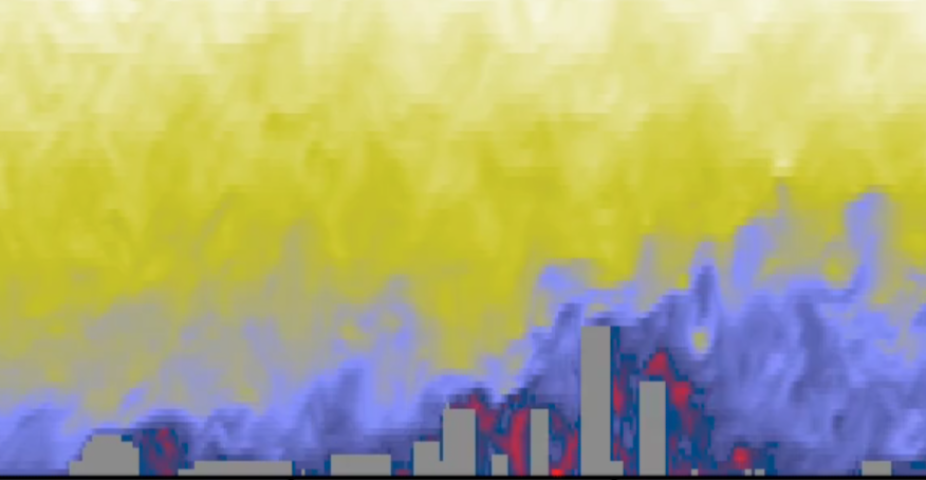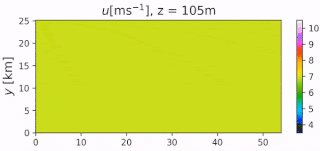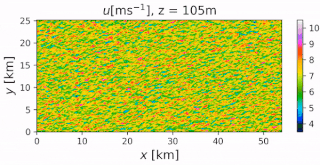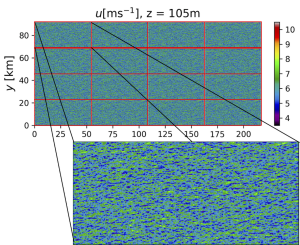FastEddy®


Announcing FastEddy® 4.0 the latest release of this groundbreaking, open source GPU-based model. Extensions include explicit incorporation of models for buildings, wind turbine effects & more.
Try it now: Latest Release
Please send us your valuable feedback on the release to fasteddy@ucar.edu.
The FastEddy® model is a new disruptive-capability software product for numerical modeling of complex microscale flows utilizing advanced architectures for accelerated computing (faster, higher-fidelity modeling and prediction). To date, the application of the Large-Eddy Simulation (LES) technique has been restricted to fundamental research due to the substantial computational expense of the method. Nonetheless, the efficacy of this method in capturing the influence of turbulence across a plethora of application scenarios only continues to grow.
FastEddy limited area domain simulation with the cell perturbation method for resolved turbulence instigation (top) versus a periodic domain reference simulation (bottom). This feature allows FastEddy to be applied real-world locations for specific times and dates. The longer-term goal is to provide synchronization of FastEddy simulations as nested-domains driven by WRF mesoscale forecast simulations (e.g. High Resolution Rapid Refresh, HRRR forecasts).
FastEddy is a new modeling system targeting general purpose graphics processing unit (GPGPU) architectures in order to achieve at least order-of-magnitude performance gains. Such performance gains are the crucial requirement for realization of the LES method as a viable tool for microscale operational, educational, and more comprehensive research applications.
FastEddy is a new hybrid CPU/GPU-accelerated, LES model developed within RAL-NSAP beginning in FY2017. Applications of this model target turbulence-resolving microscale atmospheric boundary layer flow simulation with atmospheric transport and dispersion of hazardous species and greenhouse gases. FastEddy is a resident-GPU model, meaning that all prognostic calculations are carried out in an accelerated manner on the GPU with CPU utilization strictly limited to model configuration and input/output of modeling results. This resident GPU approach shows tremendous early potential for achieving faster-than-real-time microscale simulations across domains of order 100-1000 km2 at a resolution of O(10m).
FastEddy has been extended to allow for multiple GPU execution, alleviating the limited memory constraints on domain size for single GPU simulations. Here, the foreground image shows a single domain of size 22.5 km x 54 km consisting of ~10 million gridpoints run on a single GPU. The background image shows the results of utilizing 16 GPUs under horizontal domain decomposition via MPI, to model a domain 16 times larger (90 km x 216 km, 160 million gridpoints) at the same, sub-100m resolution.
FastEddy accelerated simulations can yield new insights and advantageous prediction capability across a wide range of customer applications including transport and dispersion, wind-energy, wildland fire, and urban environment operational and research endeavors. Please contact relevant RAL program directors in order to acquire access to this product for your own research and application needs.
This animation, produced using FastEddy®, shows winds changing direction and speed as a cold front passes through downtown Dallas.
Animation from a coupled WRF-FastEddy multiscale simulation supporting urban air mobility considerations. Covering approximately 81 square kilometers in the Dallas/Fort Worth, Texas, area during a November 2019 cold front passage, it shows near-surface wind speed across an area including street-canyon and building wake flow conditions.
Publications
- The FastEddy® resident-GPU accelerated large-eddy simulation framework: model formulation, dynamical-core validation and performance benchmarks
- Inclusion of building-resolving capabilities into the FastEddy® GPU-LES model using an immersed body force method
- Large-eddy simulations of stability-varying atmospheric boundary layer flow over isolated buildings
- Efficient GPU modeling of street-scale weather effects in support of aerial operations in the urban environment
- The FastEddy® resident-GPU accelerated large-eddy simulation framework: Moist Dynamics Extension, Validation and Sensitivities of Modeling Non-Precipitating Shallow Cumulus Clouds
- On the Application of an Observations-Based Machine Learning Parameterization of Surface Layer Fluxes Within an Atmospheric Large-Eddy Simulation Model
- Application of the NCAR FastEddy® Microscale Model to a Lake Breeze Front
- Implementation and Validation of a Generalized Actuator Disk Parameterization for Wind Turbine Simulations Within the FastEddy Model
- Multiscale weather forecasting sensitivities to urban characteristics and atmospheric conditions during a cold front passage over the Dallas-Fort Worth metroplex


